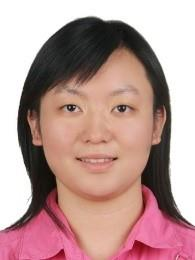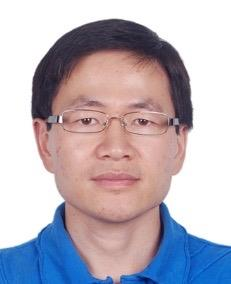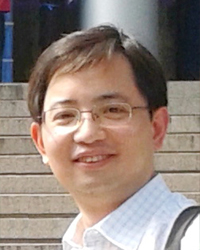Human identification at a distance by gait and face analysis
Yongzhen Huang, Daoliang Tan, Man Zhang, and Liang Wang
Monday, August 20, 2018, 09:00-12:00, 307A, 3rd Floor
Tutorial Abstract
Human identification at a distance is a very challenging task, which has long been a popular research topic in the field of computer vision. The gait sequences of different people can be very distinctive, which makes gait an important body characteristic that can be used for human identification. However, to the best of our knowledge, currently there are very few tutorials concerning this important area. Now we have made great progress in this area and we can recognize an individual at a distance via fusing gait and face recognition. We want to share our experiences with the computer vision community in ICPR 2018. We believe that our tutorial can be of interest to a substantial part of the ICPR audience.
Tutorial Outline
The outline of the proposed half-day tutorial:
Ø Introduction and overview of the tutorial: Motivations, challenges, available gait and face datasets. (15~20 minutes)
Ø A comprehensive survey on the whole pipeline of gait- and face-based human identification. (50~60 minutes)
· Traditional approaches for gait- and face- based human identification at a distance
a) Image representation.
b) Feature dimensionality reduction.
c) Classification.
· Advanced deep learning approaches for gait- and face- based human identification at a distance
a) The network architecture design for gait and face recognition
b) The influencing factors to the performance such as input features, input resolution, temporal information, data augmentation, etc.
c) State-of-the-art gait and face recognition results on common benchmarks
Ø Applications of gait and face recognition in different kinds of visual tasks. (30~40 minutes)
Ø Suggestions in practice and discussion on potential directions. (10~15 minutes)
Ø Open questions and discussion (15~30minutes)
Ø Introduction and overview of the tutorial: Motivations, challenges, available gait and face datasets. (15~20 minutes)
Ø A comprehensive survey on the whole pipeline of gait- and face-based human identification. (50~60 minutes)
· Traditional approaches for gait- and face- based human identification at a distance
a) Image representation.
b) Feature dimensionality reduction.
c) Classification.
· Advanced deep learning approaches for gait- and face- based human identification at a distance
a) The network architecture design for gait and face recognition
b) The influencing factors to the performance such as input features, input resolution, temporal information, data augmentation, etc.
c) State-of-the-art gait and face recognition results on common benchmarks
Ø Applications of gait and face recognition in different kinds of visual tasks. (30~40 minutes)
Ø Suggestions in practice and discussion on potential directions. (10~15 minutes)
Ø Open questions and discussion (15~30minutes)
Speaker Introduction
 Yongzhen Huang received the B.E. degree from Huazhong University of Science and Technology in 2006 and Ph.D. degree from Institute of Automation, Chinese Academy of Sciences (CASIA) in 2011. Then he joined National Laboratory of Pattern Recognition (NLPR) as an Assistant Professor in July 2011, and became an Associated Professor since Nov. 2013. His research interests include computer vision, pattern recognition, machine learning, and computational visual cognition. He has published one book and more than 50 papers in international journals and conferences such as IEEE TPAMI, IJCV, IEEE TMSC-B, IEEE TCSVT, IEEE TMM, Neurocomputing, CVPR, ICCV, NIPS, ICPR, ICIP. He has obtained several honors and awards, including the Excellent Doctoral Thesis of Chinese Association for Artificial Intelligence (2012), the Best Student Paper of Chinese Conference on Computer Vision (2015), the Champion of PASCAL VOC Challenges on object detection (2010 and 2011), the Runner-up of PASCAL VOC Challenges on object classification (2011), and the Champion of Internet Contest for Cloud & Mobile Computing on Human Segmentation with 230,000RMB (2013), the Second Prize and the Prize of Highest Accuracy with Low Energy in LPIRC (LowPower Image Recognition Challenge) (2015). Dr. Huang is currently a member of IEEE. He has served as Associate Editor of Neurocomputing, the web chair of AVSS2012, the publicity chair of CCPR2012, theprogram committee member of 6 conferences, and the peer reviewer of over 20 journals and conferences.
Yongzhen Huang received the B.E. degree from Huazhong University of Science and Technology in 2006 and Ph.D. degree from Institute of Automation, Chinese Academy of Sciences (CASIA) in 2011. Then he joined National Laboratory of Pattern Recognition (NLPR) as an Assistant Professor in July 2011, and became an Associated Professor since Nov. 2013. His research interests include computer vision, pattern recognition, machine learning, and computational visual cognition. He has published one book and more than 50 papers in international journals and conferences such as IEEE TPAMI, IJCV, IEEE TMSC-B, IEEE TCSVT, IEEE TMM, Neurocomputing, CVPR, ICCV, NIPS, ICPR, ICIP. He has obtained several honors and awards, including the Excellent Doctoral Thesis of Chinese Association for Artificial Intelligence (2012), the Best Student Paper of Chinese Conference on Computer Vision (2015), the Champion of PASCAL VOC Challenges on object detection (2010 and 2011), the Runner-up of PASCAL VOC Challenges on object classification (2011), and the Champion of Internet Contest for Cloud & Mobile Computing on Human Segmentation with 230,000RMB (2013), the Second Prize and the Prize of Highest Accuracy with Low Energy in LPIRC (LowPower Image Recognition Challenge) (2015). Dr. Huang is currently a member of IEEE. He has served as Associate Editor of Neurocomputing, the web chair of AVSS2012, the publicity chair of CCPR2012, theprogram committee member of 6 conferences, and the peer reviewer of over 20 journals and conferences.
Daoliang Tan received the B.E. degree from Beihang University in 2002 and PhD degree from Institute of Automation, Chinese Academy of Sciences in 2009. He joined Beihang University as an Assistant Professor in 2011. His research interests include pattern recognition, machine learning, computer vision, and fault diagnosis. He had published one book and more than 30 papers.
 Man Zhang received the B.E. degree from Beijing University of Posts and Telecommunications in 2008 and Ph.D. degree from Institute of Automation, Chinese Academy of Sciences (CASIA) in 2013. Then she joined Center for Research on Intelligent Perception and Computing (CRIPAC) as an Assistant Professor in July 2013, and became an Associated Professor since Nov. 2017. Her research interests include computer vision, pattern recognition and biometrics. She has published more than 20 papers in international journals and conferences such as IEEE TPAMI, IEEE TIP, Neurocomputing, AAAI, ICIP, ICB. She has obtained the Best Student Paper of ICB2016. Dr. Zhang is currently a member of IEEE. She has served as the financial chair of AVSS2012 and DSP2017, the program committee member of CCBR2016 and CCBR2017.
Man Zhang received the B.E. degree from Beijing University of Posts and Telecommunications in 2008 and Ph.D. degree from Institute of Automation, Chinese Academy of Sciences (CASIA) in 2013. Then she joined Center for Research on Intelligent Perception and Computing (CRIPAC) as an Assistant Professor in July 2013, and became an Associated Professor since Nov. 2017. Her research interests include computer vision, pattern recognition and biometrics. She has published more than 20 papers in international journals and conferences such as IEEE TPAMI, IEEE TIP, Neurocomputing, AAAI, ICIP, ICB. She has obtained the Best Student Paper of ICB2016. Dr. Zhang is currently a member of IEEE. She has served as the financial chair of AVSS2012 and DSP2017, the program committee member of CCBR2016 and CCBR2017. Liang Wang received both the B. Eng. and M. Eng. degrees in Electronic Engineering from the Department of Electronics Engineering and Information Science, Anhui University (AHU), China, in 1997 and 2000 respectively, and the PhD degree in Pattern Recognition and Intelligent System from the National Laboratory of Pattern Recognition (NLPR), Institute of Automation, Chinese Academy of Sciences (CAS), China, in 2004. After graduation, he has worked as a Research Assistant at the Department of Computing, Imperial College London, United Kingdom and at the Department of Electrical and Computer Systems Engineering, Monash University, Australia, and a Research Fellow at the Department of Computer Science and Software Engineering, University of Melbourne, Australia, respectively. Before he returned back to China, he was a Lecturer with the Department of Computer Science, University of Bath, United Kingdom. Currently, he is a Professor of Hundred Talents Program at the Institute of Automation, Chinese Academy of Sciences, P. R. China. His major research interests include machine learning, pattern recognition, computer vision, multimedia processing, and data mining. He has widely published at highly-ranked international journals such as IEEE TPAMI, IEEE TIP, IEEE TKDE, IEEE TCSVT, IEEE TSMC, CVIU, and PR, and leading international conferences such as CVPR, ICCV and ICDM. He has obtained several honors and awards such as the Special Prize of the Presidential Scholarship of Chinese Academy of Sciences and the Research Commendation from University of Melbourne in recognition of Excellent Research. He is currently a Senior Member of IEEE (Institute of Electrical and Electronics Engineers), as well as a member of IEEE Computer Society, IEEE Communications Society, IEEE Signal Processing Society, and BMVA (British Machine Vision Association). He is serving with more than 20 major international journals and more than 40 major international conferences and workshops. He is an associate editor of IEEE Transactions on Systems, Man and Cybernetics–Part B, IEEE Transactions on
Liang Wang received both the B. Eng. and M. Eng. degrees in Electronic Engineering from the Department of Electronics Engineering and Information Science, Anhui University (AHU), China, in 1997 and 2000 respectively, and the PhD degree in Pattern Recognition and Intelligent System from the National Laboratory of Pattern Recognition (NLPR), Institute of Automation, Chinese Academy of Sciences (CAS), China, in 2004. After graduation, he has worked as a Research Assistant at the Department of Computing, Imperial College London, United Kingdom and at the Department of Electrical and Computer Systems Engineering, Monash University, Australia, and a Research Fellow at the Department of Computer Science and Software Engineering, University of Melbourne, Australia, respectively. Before he returned back to China, he was a Lecturer with the Department of Computer Science, University of Bath, United Kingdom. Currently, he is a Professor of Hundred Talents Program at the Institute of Automation, Chinese Academy of Sciences, P. R. China. His major research interests include machine learning, pattern recognition, computer vision, multimedia processing, and data mining. He has widely published at highly-ranked international journals such as IEEE TPAMI, IEEE TIP, IEEE TKDE, IEEE TCSVT, IEEE TSMC, CVIU, and PR, and leading international conferences such as CVPR, ICCV and ICDM. He has obtained several honors and awards such as the Special Prize of the Presidential Scholarship of Chinese Academy of Sciences and the Research Commendation from University of Melbourne in recognition of Excellent Research. He is currently a Senior Member of IEEE (Institute of Electrical and Electronics Engineers), as well as a member of IEEE Computer Society, IEEE Communications Society, IEEE Signal Processing Society, and BMVA (British Machine Vision Association). He is serving with more than 20 major international journals and more than 40 major international conferences and workshops. He is an associate editor of IEEE Transactions on Systems, Man and Cybernetics–Part B, IEEE Transactions onInformation and Forensic Security, International Journal of Image and Graphics (WorldSci), International Journal of Signal Processing (Elsevier), Neurocomputing (Elsevier), and International Journal of Cognitive Biometrics (Inderscience). He is a leading guest editor of several special issues such as PRL (Pattern Recognition Letters), IJPRAI (International Journal of Pattern Recognition and Artificial Intelligence), IEEE TIFS, and IEEE TSMC-B, as well as a co-editor of 6 edited books. He has also co-chaired 1 invited special session and 8 international workshops. He was a co-PC chair of the 9th IEEE AVSS 2012.





